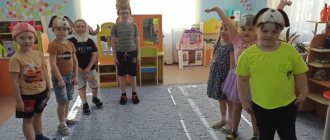MAGAZINE Preschooler.RF
The use of layouts in preschool educational institutions as an innovative technology for the cognitive development of preschool childrenAuthor: Pastukhova Lyudmila Ivanovna Educator, first qualification category MADOU “Kindergarten No. 48” Sverdlovsk region, Verkhnyaya Pyshma
According to the requirements of the Federal State Educational Standard, the subject-spatial environment must provide the opportunity for communication and joint activities of children and adults, and ensure the maximum realization of educational potential. Mandatory equipment includes materials that activate children’s cognitive activity.
Along with traditional methods, innovative pedagogical technologies are used for the intellectual development of preschool children. One of the promising technologies is prototyping.
Layout – a reduced model of an object (forest, mountains, field, lake, volcano, solar system, etc.).
The main characteristic of a model is that it reflects, contains the essential features of nature, and reproduces in a convenient form the most significant aspects and features of the modeled object.
I relied on the experience of Nadezhda Aleksandrovna Korotkova, who distinguishes the following types of layouts:
- floor, and then it has larger structural volumes
- desktop, then the size is limited by the size of the table or part of it
- podium (on special podium stands)
- wall in the form of three-dimensional subject paintings with a foreground subject plan and a background picture.
The use of game layouts in a subject-spatial environment meets the principle of integration of educational areas:
- Promote children's speech development. When working with the model, children describe, compare, talk about various phenomena and objects of nature, reason, thereby expanding their vocabulary.
- There is a close connection between the use of layouts and FEMP. In the process of work, children consolidate such mathematical concepts as space, quantity, size, etc.
- Layouts are of great importance in the development of children's play activities. The layout is considered by children as a play environment where various game plots can be developed, which contributes to the development of communicative initiative in children.
- The use of layouts plays a huge role in the cognitive development of children. The use of layouts on various topics increases the level of curiosity and cognitive interest.
- Layouts create favorable conditions for the sensory development of children: working with materials of different texture, quality, and shape promotes the development of external senses and activates fine motor skills of the hands.
- Layouts in artistic and aesthetic development help children highlight details, color, texture.
Any type of educational activity with children at all its stages requires competent organization and leadership from the teacher. Layout is no exception. The teacher highlights the main stages of work on creating and using a particular layout.
In the process of developing a game with layouts, the following tasks are solved:
- conditions are created to enrich children's ideas about the world around them.
- cognitive interest in living nature, emotional responsiveness and curiosity develops
- skills of correct behavior in nature are formed
- goodwill, responsiveness to the natural world, and careful attitude towards it are fostered.
The following forms of working with the layout are used:
- educational and research activities
- play activity
- productive activity
Methodological techniques for working with the layout:
- examination
- conversation
- reading fiction
- writing short stories
- didactic games.
In early preschool age, children are just beginning to form ideas about living nature. Simple layouts and models created by the hands of teachers form initial ideas about natural objects. But it is not the presence of the layout that shapes it, but the ability to communicate with it, the game. With younger preschoolers, work involves examining finished products and manipulating them. A conversation about nature or a natural object that the model depicts.
In the life of older preschoolers, director's play with small toys occupies a large place, when the child creates an imaginary situation, invents an event with characters, identifying himself with them, performing one of several roles, and modeling real social relationships in a playful form.
A model is a type of children's activity that helps to consolidate ideas about the natural world, allows one to transform acquired knowledge into play, saturating children's lives with new impressions and stimulating children's creativity. The layout is the result of constructive and creative activity and a very attractive playing space. Kids love playing with these layouts! The work of making models is labor-intensive, but very interesting!
I present some of the models that I made for my students. They are made of various materials. Layouts are multifunctional and their use in work is multifaceted, which makes it possible to solve many problems.
- Layout “On the roads and streets of the city” . The layout represents the roadway and parts of the street. Contains models of buildings and cars. It's two-sided. On the other side
"park" , "streets" .
- Layout "Waterfall"
- Africa layout
- Layout "Garden"
- Layout "Village Compound"
- Layout "World of Insects"
- Layout "Antarctica"
- Layout "Russian hut"
- Model “Water cycle in nature”
- Layout "In the world of dinosaurs"
- Layout "Forest floors"
- Layout "Fairy Tale on the Carpet"
Thus, the use of models in working with children is one of the innovative technologies that contribute to the formation of gaming skills, search activity and cognitive activity of each child. I am convinced that the use of layouts in preschool educational institutions will take its rightful place in the process of cognitive activity of preschool children.
Used Books:
- Nishcheva N.V. Subject-spatial developmental environment in kindergarten. Principles of construction, advice, recommendations / Nishcheva // Childhood - Press. – 2010.
- Korotkova N. A. Educational process in groups of children of senior preschool age. – M.: LINKA – PRESS, – 2007.
- Mikhailenko N. Ya., Korotkova N. A. Organization of story-based games in kindergarten. M.: "Gnome and D" , - 1997.
- Mikhailenko N. Ya., Korotkova N. A. How to play with a child. M.: Academic project, - 2001.
| Next > |
Creation of layouts of kindergartens of any complexity
Preschools, as separate buildings, first appeared in Germany at the beginning of the nineteenth century. The creator of this concept was the German educator and theorist Friedrich Froebel, and at the end of the 19th century, Rudolf Steiner, an Austrian philosopher and architect, discovered the influence of the architectural environment on the psychological state of the child.
Currently, in Russia, the design of preschool institutions is aimed, first of all, at fulfilling the exclusively utilitarian function of temporarily placing children in a strictly controlled environment, therefore the block principle of kindergarten architecture has remained unchanged since Soviet times.
In other countries, for many years, a fundamentally different approach has been used: the buildings of preschool institutions are considered as an intermediary for the perception of the outside world and a catalyst for the social adaptation of children. The kindergarten project should be aimed at creating an environment that develops the mental, physical and creative abilities of the child.
In the eighties, architects came to the conclusion that preschool institutions were a completely new type of building that required a special approach to design. At the same time, four basic principles for preschool design were developed.
The first approach is metaphorical. A good example is the KITA kindergarten project in Frankfurt. Architect Christophe Makler believed that there was no such thing as architecture for children. There are no so-called “childish elements” in his project. He used the metaphor of a small town, where the classrooms are a kind of terraced houses and the corridor acts as a street.
Source: archdaily.com
The second approach is organic. In his kindergarten project, the Austrian architect Hundertwasser tried to establish a connection between man and nature through architectural solutions.
Source: needpix.com
The third approach is the inclusion of late modern structural elements into the project. According to architects who follow this principle, a building is just a frame, a neutral shell, and the substantive elements must be placed inside. An example of such a design solution is the kindergarten of architect Wilson.
Source: archdaily.com
The fourth method, based on Judith Seaver's study "Philosophy of the Educational Approach", argues that the design of preschools should be directly linked to the educational program, combining structured activities, such as planned activities, and unstructured ones, allowing the child to choose his own activities.
Source: archdaily.com
Based on numerous studies by psychologists and architects, principles have been determined for the design of preschool institutions that function as “giant play spaces” - with an open plan, child-friendly sizes of elements and secluded corners where the child can, if necessary, relax and be alone. An ecological approach to design aims to provide visual diversity in form, use parts of the building as play elements, transform boring walkways into integral parts of playgrounds and seamlessly integrate the building into the surrounding space.
Children, following their inner impulses, choose what they want to do. In this way, a permanent active space is formed without “idle” places.
When designing kindergartens and preschool institutions, it is necessary to create 3D models of buildings and surrounding areas. In addition to the design and presentation functions performed by the model during construction, it can also be used in the institution itself, for example, to explain to children in an accessible playful way the escape routes in the event of any threats.
Possibilities
Three-dimensional layout when designing modern preschool institutions allows architects to create an open layout of spaces and abandon traditional corridors.
In large areas, with the help of movable partitions, different floor levels, different floor coverings and other methods, dynamically changing zones can be created, both for relaxation and for active games. Psychologists have come to the conclusion that it is necessary to take into account the scale of the surrounding space for the child: windows at the level of children’s eyes, signs, decorative elements of the appropriate height, and the like.
It’s the layouts that help you design it all correctly.
Advantages compared to manual production
Rapid 3D printing and CNC milling are the latest ways to use 3D processes in architectural modeling. Three-dimensional plans, sectional structures, models of buildings and entire cities - realistic scaled models of a wide range of sizes can be quickly produced and changed, depending on the current task.
About the advantages of using additive technologies in 3D prototyping, features of working with Top 3D Shop, production times, technologies used, ordering procedures, equipment and materials used, read the article “3D technologies in architectural prototyping”.



